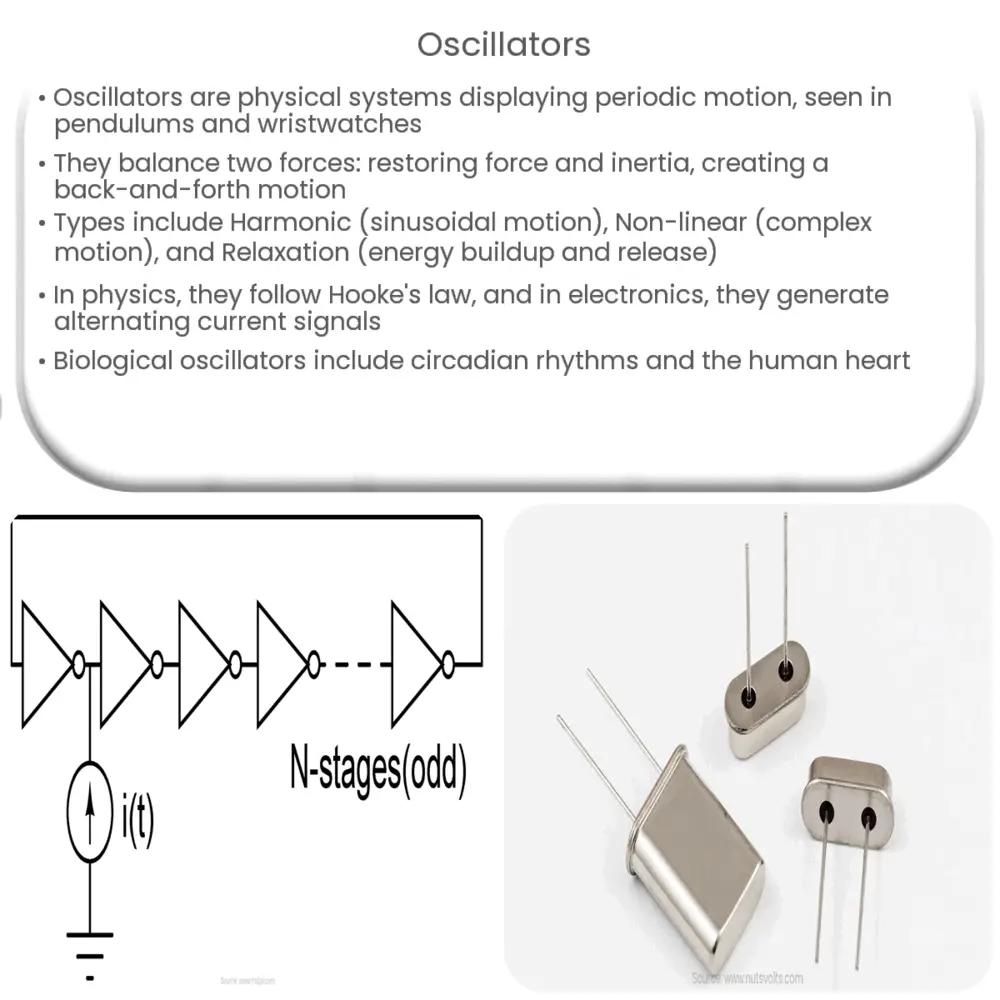Explore the fascinating world of oscillators: from physics and electronics to biology, and their pivotal role in our universe.

Oscillators: An Insight into Periodic Motion
An oscillator is a physical system that repeats its state over a period of time, in what is known as periodic motion. This concept, ubiquitous in both the natural world and technological applications, can be found in everything from the swinging of a pendulum to the functioning of a wristwatch. Let’s delve deeper into the fascinating world of oscillators.
The Basics of Oscillators
At the heart of an oscillator is the balance of two primary forces: one that drives the system towards a certain position (restoring force), and another that propels the system into motion (inertia). These opposing forces create the characteristic back-and-forth motion seen in oscillators.
Types of Oscillators
- Harmonic Oscillators: This is the most basic type of oscillator and is defined by a sinusoidal (sine wave) pattern of motion. Examples include a swinging pendulum and a mass attached to a spring.
- Non-linear Oscillators: These oscillators do not follow a sinusoidal pattern. Instead, their motion is defined by more complex mathematical functions. A bouncing ball is an example of a non-linear oscillator.
- Relaxation Oscillators: In these oscillators, the system slowly builds up energy and then releases it in a sudden burst, causing the system to reset and the process to begin anew. This type of oscillation is found in certain electronic circuits and biological systems, such as the firing of neurons.
Oscillators in Physics
In physics, oscillators are described using Hooke’s law, which states that the force exerted by a spring is proportional to the displacement of the spring from its equilibrium position. This law can be represented mathematically as F = -kx, where F is the force, k is the spring constant, and x is the displacement.
The behavior of an oscillator can also be explained using the principle of conservation of energy. For a simple harmonic oscillator like a pendulum, the system’s potential energy and kinetic energy continually interchange as the pendulum swings back and forth, but the total energy remains constant.
In quantum mechanics, the quantum harmonic oscillator model helps in understanding the behavior of quantum particles in a state of potential energy. This oscillator is used as a fundamental building block in quantum field theory, a branch of physics that describes the fundamental forces and particles in the universe.
Oscillators in Electronics
Electronic oscillators are essential components in a myriad of technologies. They create alternating current signals, which are utilized in countless devices, from radios and televisions to cell phones and computers.
There are several types of electronic oscillators, each with their own unique properties and uses. These include:
- RC (Resistor-Capacitor) Oscillators: These utilize the charging and discharging of a capacitor through a resistor to generate an oscillating signal.
- LC (Inductor-Capacitor) Oscillators: LC oscillators use the oscillating current in an LC circuit (an electrical circuit composed of an inductor and a capacitor) to create a signal.
- Crystal Oscillators: These oscillators make use of the mechanical resonance of a vibrating crystal (often quartz) to generate an electrical signal with a very precise frequency.
Oscillators in Biology
Oscillators are not just limited to physical and electronic systems. They also play a crucial role in biological systems. Circadian rhythms, for instance, are the result of biological oscillators that drive daily cycles in many physiological processes, including sleep-wake cycles and feeding patterns.
The human heart is another example of a biological oscillator, with its rhythmic contractions and relaxations essential for pumping blood throughout the body. Furthermore, many neural systems function as oscillators, with neurons firing in synchrony to produce brain waves associated with different states of consciousness.
Conclusion
In conclusion, oscillators, with their characteristic periodic motion, are fundamental elements in an array of fields. From the swing of a pendulum to the ticking of a clock, the oscillation of electrical circuits to the rhythmic firing of neurons, these systems form the backbone of numerous natural phenomena and technological applications.
The study and understanding of oscillators provide us with valuable insights into the workings of the universe, right from the microscopic quantum particles to the vast cosmos, and everything in between. Truly, oscillators represent a profound interconnection between different realms of science, offering a unified perspective that underscores the harmonious dance of order and chaos, inertia and force, the physical and the abstract.




